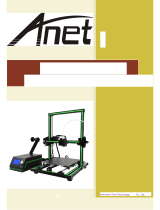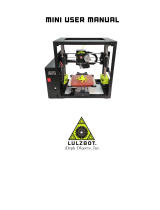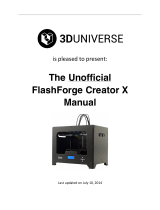Page is loading ...

WARNING!
• Hot surfaces! Do not touch the heat nozzle and the construction
platform in operation!
• Danger! Moving parts in printer may cause injury. Do not wear
gloves or other sources of entanglement in operation!
Quickstart Guide
3D printer
Art. No. 2010600

More informationen, updates or software
Visit our website using the following QR code or weblink to nd additional information, available
updates or software for this product or realted accessories:
www.bresser.de/P2010600
After Sales Support / Service
We oer an individual service for this product beyond the purchase. If you have any problems with
the product, our support team will be happy to assist you.
For a smooth process, please keep the following information handy for possible inquiries:
• Warranty/Service card
• Article number and Product description
• Date of purchase and dealer
Contact details:
e-Mail: service.3d@bresser.de (preferred communication)
Internet: www.bresser.de/c/de/service
Phone*: 00 800 – 63 43 7000
Service hours:
Monday to Friday (except national public holidays) 9:00 a.m. to 3:00 p.m. CET
* free hotline throughout Europe
Warranty
Please refer to the separate warranty & service card for any warranty information.

- 3 -
3D printer Filament spool Top cover Service card Quickstart guide
Power cable USB cable SD card Spool holder Build tape
Screwdriver Stamping
wrench
Allen wrench Pin tool Scraper
PTFE tube Guide tube Grease Glue stick Anti-oozing plate
Levelling card Levelling nut
Set contents

- 4 -
Unpacking
This 3D printer set was packed with care. Please follow the unpacking steps laid
out below.
1. Open the box and remove the top
foam piece.
2. Firmly grasp the two side handles of
the 3D printer. Lift it out of the carton
and place it on a stable and plane
surface.
3. Remove the packaging bag and then
remove the tape and plastic wrap for
protecting the front door.
4. The accessories are placed in a foam
shape in the printer's top opening.
Take out all accessories except the
two extruders which are alraedy
cable connected with the printer.
CAUTION!
• Remove the package and take out accessories carefully! Do not use
force!
• Do not tear off the yellow adhesive tape around the nozzle. It has
thermal insulation and high temperature resistance characteristics.

- 5 -
5. Carefully take the extruder out of
the foam shape. Avoid the nozzle
touching the desk to prevent from
scratching it.
6. Remove the foam shape. Use a
scissors to cut the two ties on both
sides of the x-axis guide rail and
remove them.
7. Open the door and take out the
printer's top cover lid. Take the
lament out of the lid.
8. Hold the printing platform on both
sides and lift it up slowly to facilitate
the removal of the foam piece below.
9. Take the foam piece out of the
printer's bottom. Slowly press the
platform downwards by hand to the
lowest position for easy subsequent
installation.
10. Unpacking is completed. It
is recommended to keep the
packaging material for further
transportation or storage.

- 6 -
Parts overview
1. Printing platform
2. Platform support
3. Leveling nut
4. LCD panel
5. Z-axis guide rail
6. Extruder cable bunch
7. X-axis guid rail
8. Slot
9. Nozzle cooling fan
10. Spring presser
11. Main cooling fan
12. Nozzle
13. Turbofan bae
14. Extruder bracket
15. SD card slot
16. USB cable input
17. Guide tube buckle
18. Spool holder slot
19. Spool holder
20. Power input
21. Power switch

- 7 -
Installation
1. Lower the platform and place the
dual extruder on the extruder seat.
2. Take the M2.5 Allen wrench from the
tool bag and four M3 bolts from the
accessory kit.
3. Adjust the extruder above the
extruder bracket to align the holes
for the bolts.
4. Fix the extruder onto the extruder
bracket by screwing in the M3 bolts
as shown.
Assempling the extruder
Extruder
Extruder bracket
Bolts
Holes for bolts

- 8 -
Installing guide tube and lament
1. Level the spool holder and insert it with its plate facing forward into the
corresponding opening at the printer's backside.
2. Turn down the spool holder to make the holder bottom cleave to the printer's
backside.
3. Squeeze the spool holder top and put the lament spool onto the holder.
squeeze
Refer to the next page to learn more about
the right lament installation method.

- 9 -
M3x8
1. The lament spool must be oriented
corectly (see below illustrations)
2. After the guide tube xation is
completed, press the left spring
presser of the extruder, put the
lament vertically into the left
lament intake from the other end of
the guide tube.
Install the top cover when printing ABS.
Remove the top cover when printing
PLA.
Fix the anti-oozing
plate by two M3x8
screws.
Make sure that the nozzle touches
the anti-oozing plate properly when
installed. The distance between the
nozzle and the plate can be adjusted
manually. After printing, scratches on
the plate surface can be visible. This is
not a failure but normal.
NOTE: Pay attention to extend the guide tube to the inside of the spool to prevent
the lament from being wrapped outside the spool.
Make sure that the two lament strands are installed in crossed position.
Important tips
Installing the top cover Installing the anti-oozing plate
Guide tube
buckle
Limited seat
Lock the guide tube with R-shape
buckles.

- 10 -
Print
R Extruder
Heating...
Preheat Tools
Manual
General settings
1. Tap on [Tools] > [Filament]
2. Tap on [Load] to start the extruder heating up. After the target temperature is
reached, manually insert the lament into the lament feeding wheel. When the
lament is ejected from the nozzle, it indicates that loading is completed.
2. Tap on [Unload] to start the extruder heating up. After the target temperature
is reached, manually feed out a part of lament from the nozzle. Then at the same
time press down the spring presser and quickly pull out the lament.
Loading/Unloading the lament

- 11 -
Manual
Next
Next
Next
1. Tap on [Tools] > [Level] to start leveling. The printer will nish homing rst.
IMPORTANT NOTE: This needs to be done to avoid scratches to the build plate by
the extruder!
3. Choose one extruder and move it to the rst nut by hand. Place a paper under
the extruder and tighten the nut to reduce the distance between extruder and
platform. Gently move the paper and feel the friction. If the paper can be moved
with gent friction, the distance between extruder and platform is suitable. Finish
the initial placement and repeat this step for the secend and third nut.
NOTE: A small distance between extruder and platform causes removing printed
objects hard, while a big distance causes adhesion fails or wrapping.
Leveling
2. After stoping movement of extruder
and platform, tighten the three nuts
below the platform counterclockwise.

- 12 -
Print Preheat Tools
Z:0.08
OK
Z Calibration
proper distance.
Manual
X
Calibration
Y
Calibration
Z
Calibration
Expert
Mode
FactoryReset
1. Tap on [Tools] > [Setting] > [Z calibration]. The printer uses a compensation layer
mechanism. Instead of manually adjusting the installation positions of the left
and right nozzles, a program is used to calculate the height difference between
the two nozzles.
2. Tap [Tools] > [Setting] > [Z calibration]. The printer uses a compensation layer
mechanism. Instead of manually adjusting the installation positions of the left
and right nozzles, a program is used to calculate the height difference between
the two nozzles. The extruder and platform will return to the zero position rst,
select any extruder to calibrate. The sytem is waiting until the temperature is
cooled down to 50 ° C to prevent the nozzle from scalding the build tape.
3. Follow the on-screen instructions and insert the leveling card between the nozzle
and the platform. Tap on [Z-] or [Z+] to adjust the appropriate spacing. The
adjustment range is sliding leveling paper. If you feel a little frictional resistance,
it indicates that the distance between the nozzle and the platform is appropriate.
When on extruder is adjusted, it will be switched to another extruder for
calibration.
Calibrating the axis
Z-axis calibration
NOTE: Do not turn the nuts under
the platform during Z-axis
calibration.

- 13 -
X-axis calibration is used to adjust the consistency of the two extruders in the
X-axis direction to prevent misalignment during printing.
IMPORTANT NOTE: Make sure that the lament has been inserted into the
extruder before starting the x-axis calibration.
X-axis calibration
1. Tap on [Setting] > [X Calibration], or continue the X-axis calibration after the
Z-axis calibration is completed. After the machine initialization movement is
completed, the nozzle and the platform will be heated. At this time, please
ensure that the lament has been inserted into the extruder.
2. After heating, left and right extruders print a line one by one.
3. According to the actual printed lines, click X-, X + to adjust the bias of the
extruders and remove the printed lines; tap the verify button, the left and right
extruders will print the lines again to see if the lines coincide, if they coincide, it
means that the X-axis calibration is completed, if they are inconsistent, continue
to adjust, until it coincides.

- 14 -
Y-axis calibration is used to adjust the consistency of the two extruders in the Y-axis
direction to prevent misalignment during printing.
Y-axis calibration
1. Tap [Setting]-[Y Calibration], or continue the Y-axis calibration after the X-axis
calibration is completed. After the machine initialization movement is completed,
the nozzle and the platform will be heated. At this time, please ensure that the
lament has been inserted into the extruder.
2. After heating, left and right extruders print a line one by one.
3. According to the actual printed lines, click Y-, Y + to adjust the bias of the
extruders and remove the printed lines; tap the verify button, the left and right
extruders will print the lines again to see if the lines coincide, if they coincide, it
means that the Y-axis calibration is completed, if they are inconsistent, continue
to adjust, until it coincides.

- 15 -
Print
Test
sys
Preheat Tools
After installing, loading lament and calibrating, it start your rst print.
1. Insert the SD card to the side of machine.
2. Tap on [Print] > [SD card] > [Test]. Choose a test le from the folder for a rst
print.
First print

Bresser GmbH
Gutenbergstr. 2 · DE-46414 Rhede
Germany
www.bresser.de · [email protected]
Errors and technical changes reserved.
Quickstart_2010600_T-REX-2-3D-printer_en_BRESSER_082020a
/







